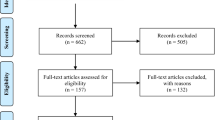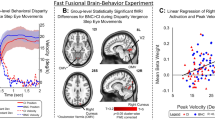Abstract
Aim
There is a controversy as to whether dyslexic children present visuo-motor disabilities such as vergence and accommodative problems assessed with orthoptic tests. The purpose of this study is to re-examine this issue in a large population of children.
Methods
Extensive orthoptic evaluation was made in 57 dyslexic and 46 non-dyslexic (“normal”) age-matched children. Convergence and divergence capacities were evaluated at two distances (30 cm and 400 cm).
Results
Binocular vision measured with stereo-acuity tests was normal in dyslexics. In contrast, the near point of convergence was significantly more remote in dyslexics; most importantly, divergence at both far and near distance was significantly more reduced in dyslexics (median value 4 pD and 10 pD, respectively, at far and near) than in “normals” (median value 6 pD and 12 pD, at far and near).
Conclusion
The existence of the divergence deficit at far distance indicates the presence of deficit of divergence per se, independently from convergence and accommodation relaxation. This result is novel and corroborated by physiological studies indicating distinct control of convergence and divergence, both at the cortical and subcortical premotor level. We conclude that vergence deficits are frequently present in dyslexics, and that dyslexics should be re-educated; training should address distinctively convergence and divergence subsystems.



Similar content being viewed by others
References
Bucci MP, Kapoula Z, Yang Q, Bremond-Gignac D, Wiener-Vacher S (2004) Speed-accuracy of saccades, vergence and combined eye movements in children with vertigo. Exp Brain Res 157:286–295
Bucci MP, Kapoula Z, Yang Q, Wiener-Vacher S, Bremond-Gignac D (2004) Abnormality of vergence latency in children with vertigo. J Neurol 251(2):204–213
Bucci MP, Pouvreau N, Yang Q, Kapoula Z (2005) Influence of gap and overlap paradigms on saccade latencies and vergence eye movements in seven-year-old children. Exp Brain Res 164:48–57
Bucci MP, Kapoula Z (2006) Binocular coordination of saccades in 7 year old children in single word reading and target fixation. Vision Res 46:457–466
Chevrie-Muller C, Simon AM, Fournier S (1997) Batterie Langage oral écrit. Mémoire. Attention (L2MA) Paris, Editions du Centre de Psychologie appliquée
Coubard O, Daunys G, Kapoula Z (2004) Gap effects on saccade and vergence latency. Exp Brain Res 154(3):368–381
Coubard O, Kapoula Z (2006) Dorsolateral prefrontal cortex prevents short-latency saccade and vergence: a TMS study. Cereb Cortex 16(3):425–436
Eden GF, Stein JF, Wood HM, Wood FB (1994) Differences in eye movements and reading problems in dyslexic and normal children. Vision Res 34(10):1345–1358
Evans BJ, Drasdo N, Richards IL (1994) Investigation of accommodative and binocular function in dyslexia. Ophthalmic Physiol Opt 14(1):5–19
Gamlin PD, Yoon K (2000) An area for vergence eye movement in primate frontal cortex. Nature 407(6807):1003–1007
Mays LE (1984) Neural control of vergence eye movements: convergence and divergence neurons in midbrain. J Neurophysiol 51(5):1091–1108
Riddell PM, Fowler MS, Stein JF (1990) Spatial discrimination in children with poor vergence control. Percept Mot Skills 70(3 Pt 1):707–718
Stein JF, Riddell PM, Fowler MS (1987) Fine binocular control in dyslexic children. Eye 1(Pt 3):433–438
Stein JF, Riddell PM, Fowler S (1988) Disordered vergence control in dyslexic children. Br J Ophthalmol 72(3):162–166
Stein JF (2001) The magnocellular theory of developmental dyslexia. Dyslexia 7(1):12–36
Tzelepi A, Lutz A, Kapoula Z (2004) EEG activity related to preparation and suppression of eye movements in 3-D space. Exp Brain Res 155(4):439–449
von Noorden GK (2002) Binocular vision and ocular motility: theory and management of strabismus, 6th edn. Mosby, St. Louis
Yang Q, Bucci MP, Kapoula Z (2002) The latency of saccades, vergence, and combined eye movements in children and in adults. Invest Ophthalmol Vis Sci 43(9):2939–2949
Yang Q, Kapoula Z (2003) Binocular coordination of saccades at far and at near in children and in adults. J Vis 3(8):554–561
Ygge J, Lennerstrand G, Axelsson I, Rydberg A (1993) Visual functions in a Swedish population of dyslexic and normally reading children. Acta Ophthalmol 71(1):1–9
Ygge J, Lennerstrand G, Rydberg A, Wijecoon S, Pettersson BM (1993) Oculomotor functions in a Swedish population of dyslexic and normally reading children. Acta Ophthalmol (Copenh) 71(1):10–21
Acknowledgements
We are grateful to the Service de Psychopathologie de l’enfant et de l’adolescent (Dr. M.-F. Le Heuzey and Pr. M.C. Mouren-Simeoni) at the paediatric hospital Robert Debré for the recruitment of the children. We thank Mme C. Quilici, Director of the College of Saint Sulpice for allowing us to study dyslexic and non-dyslexic children at school. Thanks to O. Coubard for advice on statistics and Mlle H. Puech, optometrist, for insightful discussion on the meaning of orthoptic tests.
Author information
Authors and Affiliations
Corresponding author
Rights and permissions
About this article
Cite this article
Kapoula, Z., Bucci, M.P., Jurion, F. et al. Evidence for frequent divergence impairment in French dyslexic children: deficit of convergence relaxation or of divergence per se?. Graefes Arch Clin Exp Ophthalmol 245, 931–936 (2006). https://doi.org/10.1007/s00417-006-0490-4
Received:
Revised:
Accepted:
Published:
Issue Date:
DOI: https://doi.org/10.1007/s00417-006-0490-4




